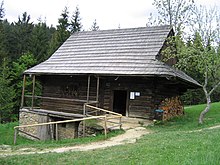
Adobe is a building material made from earth and organic materials. Adobe is Spanish for mudbrick. In some English-speaking regions of Spanish heritage, such as the Southwestern United States, the term is used to refer to any kind of earthen construction, or various architectural styles like Pueblo Revival or Territorial Revival. Most adobe buildings are similar in appearance to cob and rammed earth buildings. Adobe is among the earliest building materials, and is used throughout the world.
The wooden churches of Maramureș in the Maramureș region of northern Transylvania are a group of almost one hundred Orthodox churches, and occasionally Greek-Catholic ones, of different architectural solutions from different periods and areas. The Maramureș churches are high timber constructions with characteristic tall, slim bell towers at the western end of the building. They are a particular vernacular expression of the cultural landscape of this mountainous area of northern Romania.

Timber framing and "post-and-beam" construction are traditional methods of building with heavy timbers, creating structures using squared-off and carefully fitted and joined timbers with joints secured by large wooden pegs. If the structural frame of load-bearing timber is left exposed on the exterior of the building it may be referred to as half-timbered, and in many cases the infill between timbers will be used for decorative effect. The country most known for this kind of architecture is Germany, where timber-framed houses are spread all over the country.

Vernacular architecture is building done outside any academic tradition, and without professional guidance. It is not a particular architectural movement or style, but rather a broad category, encompassing a wide range and variety of building types, with differing methods of construction, from around the world, both historical and extant and classical and modern. Vernacular architecture constitutes 95% of the world's built environment, as estimated in 1995 by Amos Rapoport, as measured against the small percentage of new buildings every year designed by architects and built by engineers.

Natural building is the construction of buildings using systems and materials that emphasize sustainability. This in turn implies durability and the use of minimally processed, plentiful or renewable resources, as well as those that, while recycled or salvaged, produce healthy living environments and maintain indoor air quality. Natural building tends to rely on human labor, more than technology. As Michael G. Smith observes, it depends on "local ecology, geology and climate; on the character of the particular building site, and on the needs and personalities of the builders and users."
The architecture of the California missions was influenced by several factors, those being the limitations in the construction materials that were on hand, an overall lack of skilled labor, and a desire on the part of the founding priests to emulate notable structures in their Spanish homeland. While no two mission complexes are identical, they all employed the same basic building style.
A burdei or bordei is a type of pit-house or half-dugout shelter, somewhat between a sod house and a log cabin. This style is native to the Carpathian Mountains and forest steppes of Eastern Europe.
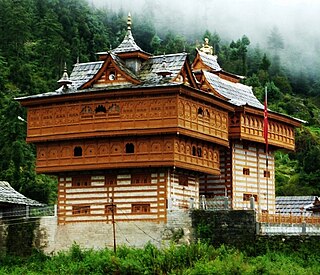
Indian vernacular architecture the informal, functional architecture of structures, often in rural areas of India, built of local materials and designed to meet the needs of the local people. The builders of these structures are unschooled in formal architectural design and their work reflects the rich diversity of India's climate, locally available building materials, and the intricate variations in local social customs and craftsmanship. It has been estimated that worldwide close to 90% of all building is vernacular, meaning that it is for daily use for ordinary, local people and built by local craftsmen.
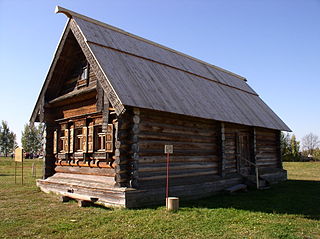
An izba is a traditional Russian countryside dwelling. Often a log house, it forms the living quarters of a conventional Russian farmstead. It is generally built close to the road and inside a yard, which also encloses a kitchen garden, hay shed, and barn within a simple woven stick fence. Traditional, old-style izba construction involved the use of simple tools, such as ropes, axes, knives, and spades. Nails were not generally used, as metal was relatively expensive, and neither were saws a common construction tool. Both interior and exterior are of split pine tree trunks, the gap between is traditionally filled with river clay, not unlike the North American log cabin.

Carpathian Wooden Churches is the name of a UNESCO World Heritage Site that consists of nine wooden religious buildings constructed between the 16th and 18th centuries in eight different locations in Slovakia. They include two Roman Catholic, three Protestant and three Greek Catholic churches plus one belfry in Hronsek. In addition to these churches there are about 50 more wooden churches in the territory of present-day Slovakia mainly in the northern and eastern part of the Prešov Region.

Wooden church architecture in Ukraine dates from the beginning of Christianity in the area and comprises a set of unique styles and forms specific to many sub-regions of the country. As a form of vernacular culture, construction of the churches in specific styles is passed on to subsequent generations. The architectural styles vary from very simple to complicated, involving a highly skilled carpentry and exceptional artistry in wood-cutting.

A mazanka is a traditional Ukrainian countryside dwelling. A house made of clay, raw brick or brushwood, plastered with clay mixed with manure or any other organic substance. The walls were later covered with lime whitewash. Historically, it was widespread in Ukraine and other territories with a significant Ukrainian minority, which was connected with natural conditions, since there were not so many forests, and therefore, wood for construction. Houses similar to mazankas were also built in the Caucasus, where they were known as turluks (palisades).

Wattle and daub is a composite building method used for making walls and buildings, in which a woven lattice of wooden strips called "wattle" is "daubed" with a sticky material usually made of some combination of wet soil, clay, sand, animal dung and straw. Wattle and daub has been used for at least 6,000 years and is still an important construction method in many parts of the world. Many historic buildings include wattle and daub construction.
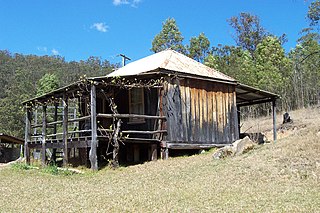
A slab hut is a kind of dwelling or shed made from slabs of split or sawn timber. It was a common form of construction used by settlers in Australia and New Zealand during their nations' colonial periods.

Carpathian Wooden Churches are religious structures made of wood and built in the Vernacular architecture of the Carpathians. These occur in the following areas:

Rumah adat are traditional houses built in any of the vernacular architecture styles of Indonesia, collectively belonging to the Austronesian architecture. The traditional houses and settlements of the several hundreds ethnic groups of Indonesia are extremely varied and all have their own specific history. It is the Indonesian variants of the whole Austronesian architecture found all over places where Austronesian people inhabited from the Pacific to Madagascar each having their own history, culture and style.

The Wooden Tserkvas of the Carpathian Region in Poland and Ukraine are a group of wooden Orthodox churches located in Poland and Ukraine which were inscribed in 2013 on the UNESCO World Heritage List which explains:
built of horizontal wooden logs between the 16th and 19th centuries by communities of Orthodox and Greek Catholic faiths. The tserkvas bear testimony to a distinct building tradition rooted in Orthodox ecclesiastic design interwoven with elements of local tradition, and symbolic references to their communities’ cosmogony. — World Heritage Centre
Lime-ash floors were an economic form of floor construction from the 15th century to the 19th century, for upper floors in parts of England where limestone or chalk were easily available. They were strong, flexible, and offered good heat and sound insulation.
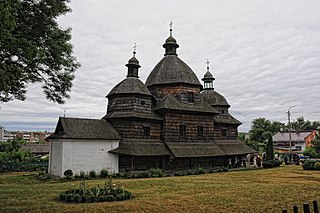
Wooden Holy Trinity Church was built in suburb of Zhovkva, Ukraine in 1720 on the place of a church that burned down in 1717. The structure consists of three wooden naves and a brick sacristy.

American historic carpentry is the historic methods with which wooden buildings were built in what is now the United States since European settlement. A number of methods were used to form the wooden walls and the types of structural carpentry are often defined by the wall, floor, and roof construction such as log, timber framed, balloon framed, or stacked plank. Some types of historic houses are called plank houses but plank house has several meanings which are discussed below. Roofs were almost always framed with wood, sometimes with timber roof trusses. Stone and brick buildings also have some wood framing for floors, interior walls and roofs.



